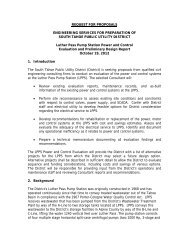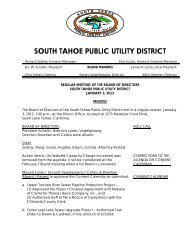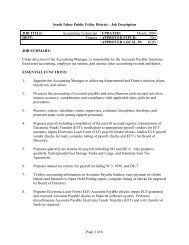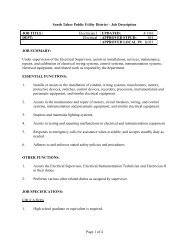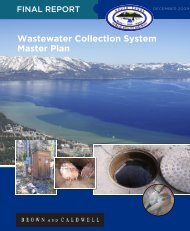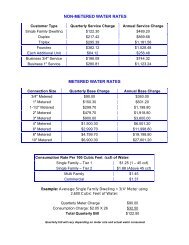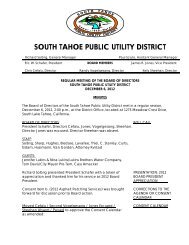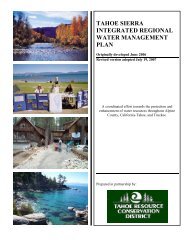October 2009 - South Tahoe Public Utility District
October 2009 - South Tahoe Public Utility District
October 2009 - South Tahoe Public Utility District
Create successful ePaper yourself
Turn your PDF publications into a flip-book with our unique Google optimized e-Paper software.
has been performed for future projects of this Master Plan, therefore an estimate of the potential<br />
revenue is not provided. No regulatory permit issues are anticipated with the implementation of<br />
this future project.<br />
Implementation of this project may compromise the system‟s reliability with regard to distribution<br />
of a known volume of recycled water if users refuse to pay. Additionally, the <strong>District</strong>‟s flexibility<br />
with regard to maintaining a consumer base of multiple users could be impacted. On the other<br />
hand, by receiving income for the use of recycled water, the <strong>District</strong> would have increased<br />
flexibility with regard to selecting and implementing system improvements.<br />
13.5.2 Biosolids Composting<br />
This project could include a future facility on the Diamond Valley Ranch that could enable the<br />
<strong>District</strong> to compost the biosoilds generated from its <strong>South</strong> Lake <strong>Tahoe</strong> wastewater treatment<br />
plant. The application of biosoilds to land is subject to environmental regulations. The long<br />
term disposal of the <strong>District</strong>‟s biosoilds is primarily an issue related to treatment plant<br />
operations. By including this project as a portion of the Master Plan the <strong>District</strong> reserves the<br />
opportunity to implement it; however, additional CEQA environmental documentation will be<br />
required.<br />
13.5.3 Become a Water Rights Buyer/Broker<br />
In this project the <strong>District</strong> could assume the role of a water rights buyer/broker with the ability to<br />
acquire surface water right entitlements for support of Indian Creek Reservoir, and remove or<br />
maintain land in production. The <strong>District</strong> already owns considerable freshwater rights that<br />
represent real value. The <strong>District</strong> could also become a water rights seller or leaser to receive<br />
benefit from the inherent value of the water rights it owns.<br />
13.5.4 Power Generation<br />
Electrical power generation was raised as a potential concept for evaluation during the initial<br />
phase of Master Plan development. Analysis was conducted to establish and evaluate potential<br />
sites for power generation facilities, the use of the electrical power supply generated, and the<br />
methods, feasibility, usefulness, overall cost and payback period for implementation.<br />
Two general alternatives were developed regarding the site for power generation. One<br />
alternative included multiple power stations along the length of the C-Line located such that<br />
pipeline pressures remained less than 150 psi. The second alternative consisted of a single<br />
power generation station located near the terminus of the C-Line. This alternative resulted in<br />
pipeline pressures exceeding 900 psi. Both alternatives were based on the use of turbines for<br />
power generation.<br />
Two general alternatives were developed regarding the use of the power generated. The first<br />
called for selling the power generated to the Sierra Pacific Power Company and feeding the<br />
generated power into the local electrical power supply grid. The other alternative called for<br />
<strong>District</strong> self-use of the power generated. In the second alternative electrical power conductors<br />
could be installed with C-Line replacement construction. The conductors could carry the<br />
generated power back to the <strong>Tahoe</strong> Basin for <strong>District</strong> use to offset electrical power costs for<br />
operation of the pump stations for the A-Line and B-Line.<br />
An economic analysis was conducted of the alternatives developed. The power generation<br />
alternative was rejected because of numerous factors. The primary reason for the rejection was<br />
that the payback period exceeded 30 years. That is, it would require more than 30 years for the<br />
<strong>South</strong> <strong>Tahoe</strong> <strong>Public</strong> <strong>Utility</strong> <strong>District</strong><br />
Recycled Water Facilities Master Plan - <strong>October</strong> <strong>2009</strong> Page 13-96



